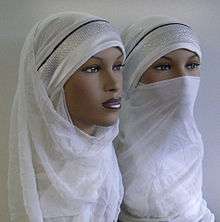Tudong
Tudong (also spelled tudung) is a Malay word, literally meaning the noun "cover", which is commonly translated/referred to as veil or headscarf in English.

 |
| Part of a series on |
| Islamic female dress |
|---|
| Types |
| Practice and law by country |
| Concepts |
| Other |
In Brunei, Malaysia and Singapore, the tudong is worn in accordance to Islam's hijab. Usually, the tudong covers the hair, ears, neck while leaving only the face exposed. It is part of the standard dress code for offices, such as school uniforms and formal occasions.
In Indonesia, a tudung is a form of hijab that has a sewn-in curved visor. In Indonesia the word more analogous to the Malaysian word tudong is "kerudung" or "jilbab".
In the southern Philippines, a tudong refers to the standard hijab as worn by Muslim women. The term is interchangable with the standard arabic term hijab (alternatively spelled hidyab in Filipino), and usually takes the form of the headwrap, visor-type, al-amira, khimar or niqab (face veil) types of veiling. A special type known as kombong (alternative spelling: combong), refers to the older style of headwrap hijab worn by Maranao, Iranun, and Maguindanao women with a semi-transcluscent shayla or malong (sarong) worn over the chest and drawn over the kombong for prayers, or for additional veiling when out of the house or familiar areas. Tudong or kombong are the native Austronesian words and cognates with Malay and Indoensian tudung or kerudung for the hijab; and are commonly used in languages as spoken by Muslim Filipinos or Bangsamoros; including the three the Danao languages of Maranao, Maguindanao and Iranun; Kaagan; and Tausug, Yakan, and Sinama (Bajau). In Tagalog or Bisaya, the standard Arabic word of hijab or English terms of headscarf, veil, or scarf are commonly used by non-Muslims to refer to the tudong instead.
External links
- (in Malay) "Tudung, hijab dan… — Aisha Adam" (Archive). The Malay Mail. 16 October 2015.